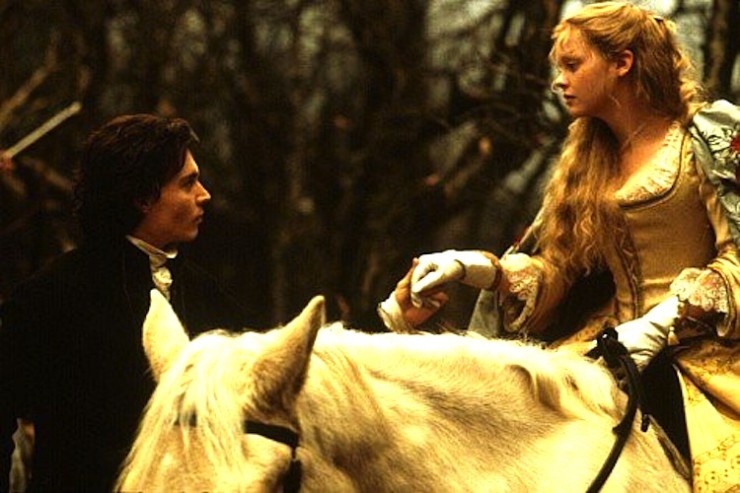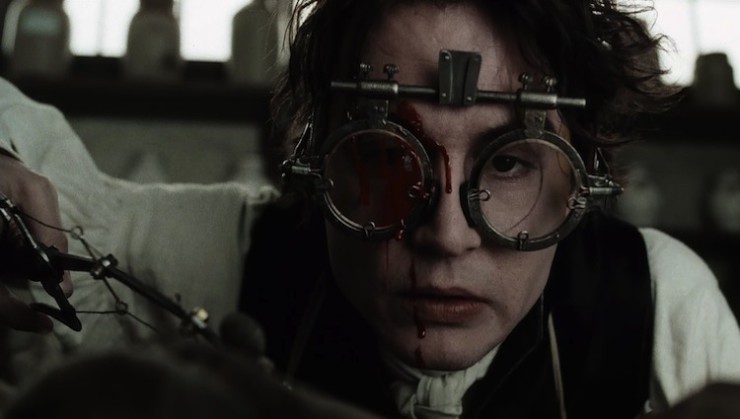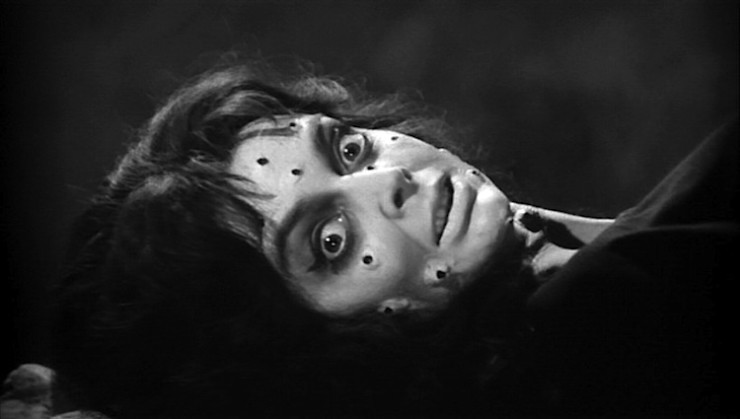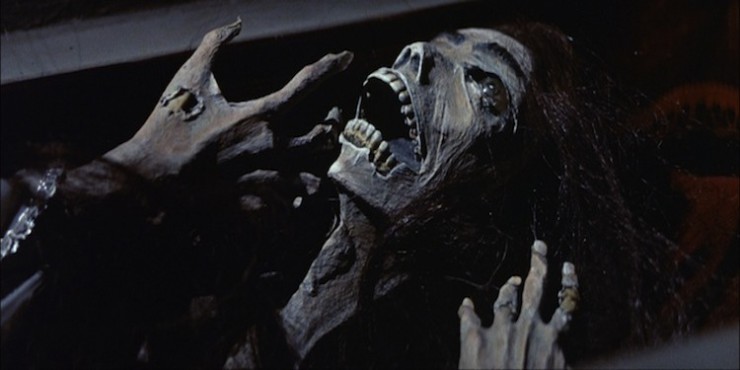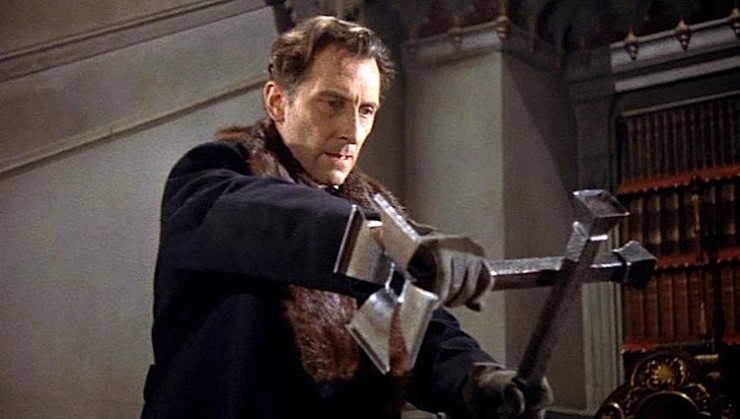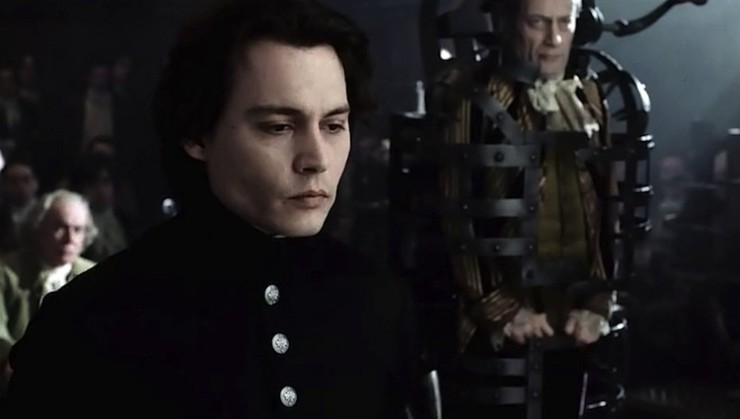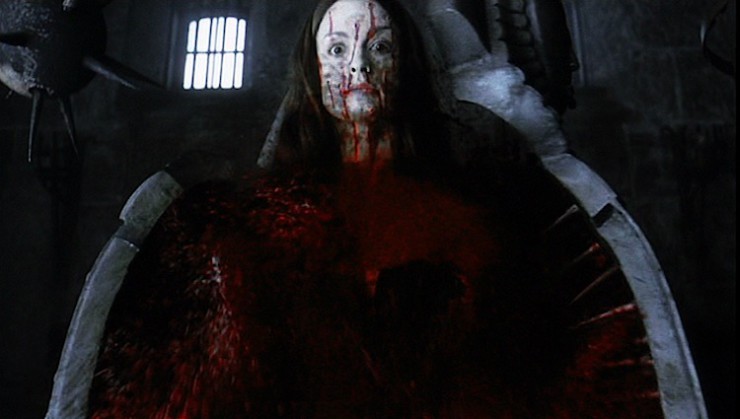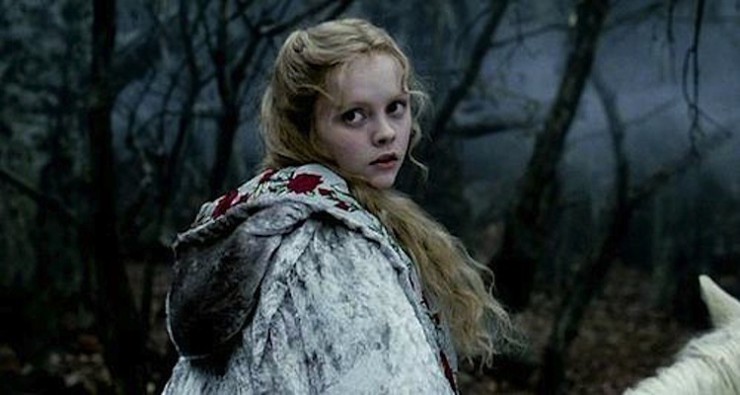When Sleepy Hollow came out in 1999, Tim Burton told everyone who interviewed him that he saw it as a love letter to Hammer Horror—and any hardcore horror fan will notice the homages to Roger Corman’s The Pit and the Pendulum and Mario Bava’s Black Sunday in there as well.
Burton’s take on Washington Irving’s folk tale begins with a stew of classic tropes: stranger comes to town to investigate a crime and discovers supernatural horror; shadowy cabal of powerful men control a small town; modern reason is pitted against ancient faith. In Sleepy Hollow, which I think is one of the best films of his career, he uses each of these near-clichés as jumping-off points to explore questions about power, gender, and spirituality. A film that could have been a rote update on an American classic, or even a slightly postmodern fairy tale, instead becomes an interrogation of a particular type of Gothic horror.
Most Hammer movies follow a basic formula before Christopher Lee starts biting people: hapless tourist/Jonathan Harker is abandoned by their (creepy) coach driver just outside of a (creepier still) mountain pass, and forced to walk to the nearest inn, where they are immediately warned to leave town by an assortment of hoary, unwelcoming villagers. Normally, a Dark Secret is alluded to. The visitor soon learns, usually in a deeply unpleasant way, that Dark Secret = Dracula. Then Peter Cushing shows up as a devout vampire hunter to end the tyrannical reign of Dracula (usually by working his way up through scantily-clad brides) all the while using every bit of religious paraphernalia he can find. He believes in vampires, knows what makes them tick, and uses a combination of wits and Christian symbolism to dispose of them.
Hammer’s visual influence is all over Sleepy Hollow, plus the movie features performances from Hammer regulars Christopher Lee and Michael Gough. Ichabod’s coachmen at least does him the favor of pulling all the way into town, but at soon as the stranger emerges from the coach, he stares up in consternation as each citizen in turn slams their window shutters. Arriving at the home of Balthus Van Tassel, he is regarded with suspicion by most, but a serving girl makes a point of whispering “Thank God you’re here.” Naturally, there’s a shadowy cabal that goes all the way to the top—and there’s no mistaking that absurdly bright red Hammer-style blood that splashes over Ichabod at every turn.
Mario Bava’s 1960 Black Sunday was also a big influence on Sleepy Hollow. It stars Barbara Steele as a 17th Century witch, and conflates her sexuality with her magical powers much as the Hammer films do with Dracula’s brides. The plot centers on the classic horror trope—a woman who has gained power through dark means must be punished for the good of the community. In this case, a horrifying spiked mask is pounded into her face before she’s burned at the stake and interred in a special crypt. When she’s accidentally resurrected (by hapless tourists, of course) part of the horror centers on the way her perfect face has been permanently scarred through the punishment:
…but the scarring doesn’t really dampen her appeal: she controls her vampiric minions more through offers of sexytimes than with displays of black magic—they don’t realize that, thanks to her execution, her body is nothing but a scarred skeleton. Her big weakness turns out to be Christian symbolism: in the end she’s vanquished by a stalwart man who notices her fear of a crucifix, strips her robe off to see the skeleton beneath, and then burns her.
Now, Burton’s other big influence is even darker. The Pit and the Pendulum (which was heavily influenced by the Bava film and was, in turn, an influence on Hammer) was already wandering astray of its source material when Richard Matheson turned Poe’s short psychological thriller into a ghost story, but then he abandons Poe completely as the movie turns into a bonkers revenge tragedy halfway through. Nicholas Medina believes his deceased wife Elizabeth is haunting him. Elizabeth’s brother shows up at the castle and demands to see proof of her death, so the two of them, joined by the Nicholas’ sister and their family doctor, break down the wall into the family crypt, crack open her casket, and discover her not-so-peaceful corpse.
(Stephen King cited this moment as one of the greatest moments of horror history, and I tend to agree.) Nicholas goes crazy, because he’s long had a fear of accidentally interring Elizabeth alive. If you think that’s a weirdly specific fear to have, well, you’re right! And Elizabeth’s brother, already reeling from shock, is now super confused. So Nicholas’ sister has to sit him down and explain some family history. Their dad was the notorious Spanish Inquisitor Sebastian Medina, and after a long career of torture he took his work home with him to punish his adulterous wife and brother. Unfortunately, he happened to do this on the one day that young Nicholas decided to sneak into the torture dungeon. Most unfortunately of all, after watching his uncle die at the hands of his father, Nicholas also witnesses as his mother is bricked up alive to die slowly from dehydration. Now with history apparently repeating itself, the dubiously sane, eternally guilty Nicholas believes he inadvertently murdered his wife.
But wait! Elizabeth isn’t dead, she’s just been faking a haunting (and planting that corpse—where did she get that???) to drive Nicholas nuts, so she and the family doctor can run off together! When Nicholas finds out the truth he goes REALLY crazy, imagines that he’s Sebastian, and starts torturing everyone he can find! And yes, the pendulum makes an appearance. The interesting thing about the movie is the way it incorporates Poe’s (totally inaccurate) vision of the Spanish Inquisition. Sebastian Medina was simply a sadist who seemed to enjoy torturing his victims, and the idea that he was acting out of any sort of faith is never even discussed. He’s a bogeyman. He uses his instruments to punish two particular adulterers, and then his son Nicholas does it as well, but without, again, any indication that he’s acting on a religious impulse—it’s pure vengeance. A story that could have been a supernatural tale, or an exploration of the evils of forced religious conversion, instead becomes a purely materialist tale of lust and vengeance. It closes with a shot of the adulterous Elizabeth locked in an iron maiden. As we’ll see, Burton quotes this shot directly in Sleepy Hollow, but in his version sexuality doesn’t enter into it, and the woman is tortured for purely religious reasons.
Tim Burton and his screenwriters took these tropes and swirled them together to create a weird throwback movie that made fascinating points about feminism and the ongoing struggle between religion and reason. To set some more context, this film came at the end of a spate of high-budget, glossy horror movies based on classics: Francis Ford Coppola’s Bram Stoker’s Dracula, Kenneth Branagh’s Mary Shelly’s Frankenstein, Mike Nichols’ Wolf, and Jan de Bont’s Shirley Jackson’s The Haunting were all prestige pictures, with big name casts (Robert DeNiro as Frankenstein’s Monster? Jack Nicholson as the Wolfman?) expected to rake in tons of money at the box office, with maybe a few awards thrown in come Oscar time. But rather than sticking with the classic source material, Burton went with a script that completely rewrites the story, turning the main character into a detective, and given magical powers to half the cast. He transforms the quintessential American folk horror story into an homage to a particular strain of European horror that most American audiences won’t even recognize, let alone appreciate. And not even satisfied with that, he’s using this film to interrogate those particular horror tropes, rather than just homage them.
But getting back to Washington Irving’s source material for a moment: Irving’s Ichabod Crane is a gawky, snotty dandy. He’s terrified by a children’s ghost story, and later uses Brom Bones’ attack as a cover to leave town after Katrina rejects him. Katrina is a pretty, flirty girl who uses Ichabod to make Brom jealous, and the townsfolk are all pretty derisive toward their lone schoolteacher. Basically, everyone in the story’s a jerk. Conversely, if we look at Peter Cushing’s Abraham Van Helsing as the typical Hammer hero (and I do, because I loooove Peter Cushing in these movies), we see he’s the direct opposite of Crane—urbane, sophisticated, an expert in the occult arts, and much much cooler than the Van Helsing you meet in Stoker’s novel. He is also devoutly religious, because you sort of have to be when you’re fighting a vampire, whipping crucifixes out of every pocket and pouch he can to ward off Satan’s minions. And, when necessary, he can improvise iconography from common household objects to keep evil at bay.
When we meet Ichabod Crane in Burton’s Sleepy Hollow, he is a perfect combination of the two heroes….with an interesting twist. Turned into a detective for the purposes of the film, he retains the original Irving character’s squeamishness, flinching away from the other constables and their ideas of “justice” which looks more like torture. Incidentally, we get an immediate one-two punch of visual references in an early courtroom scene, in which prisoners await sentencing in giant Pit and the Pendulum-esque iron maiden standing coffins, and Ichabod’s boss is played by Hammer’s own Dracula, Christopher Lee! Crane agrees to be sent off to Sleepy Hollow to investigate the murders there, but here we come to the other contrast: where Cushing’s hero invokes God at every turn, and Irving’s completely believes in the supernatural, Burton’s Crane is a rationalist. He believes in using “up-to-date scientific techniques” to investigate crime, and he scoffs at the local superstition about the Horseman. This Ichabod considers science as central to his life as Abraham Van Helsing considered his religious faith, and in the end, it’s largely Ichabod’s love of scientific inquiry that saves him.
The clash between a religious worldview and a scientific one comes to a head in his first scene with the Sleepy Hollow town elders. First, the men dismiss Lady Van Tassel so they can get down to business. Then the elders (who include another Hammer alum, Michael Gough, plus Dumbledore and Vernon Dursely) all lecture Ichabod on the Horseman, telling him the story of the Headless Hessian mercenary until his teacup is rattling in its saucer. Finally, Reverend Steenwick stomps over and drops an enormous family Bible on the table, booming, “this is the only book I recommend you read.” Crane opens the book, notes the elaborate family tree, and drops the cover back down distastefully. He doesn’t come out and say that he thinks it’s all crap, but he does tell them all, “We have murders in New York without benefit of ghouls and goblins.” So the path seems clear: Ichabod will pit his reason against small-town superstition, and most likely will be disabused of his rationalism before the end of the film.
But this isn’t quite what happens. Instead film takes a third path, one that I’m not sure I had seen a movie take up to this time. Earlier, we met Van Tassel’s daughter, Katrina, as she played a variant of blind man’s bluff called The Pickitty Witch. When we meet her next, we learn that she might take the role a bit seriously. She and Ichabod talk about the families in the town, and she offers him the gift of a small spellbook that once belonged to her late mother, “to keep it close to his heart.” He throws about as much rationalist shade as he did earlier for Steenwick, saying he “has no use for it” But when Katrina asks if he’s really so sure of everything, he chooses to keep the book. At this point, the film becomes a whole other kind of battle, and the conspiracy sinks further and further into the background as Sleepy Hollow and its irrational crimes start to work on Ichabod’s mind. Ichabod tries to get to the bottom of the murders using his scientific equipment, to the obvious scorn of the Reverend. He exhumes the lone female victim (something which was not done in 1799) and discovers that she was pregnant, which kicks off a flurry of research into inheritance and land holdings in the town, but in the end none of it turns out to matter, because Ichabod sees the Headless Horseman. In one terrible moment, he has to accept that his entire worldview as wrong. And then we find out that he has a big reason to stay away from the supernatural.
We learn about Ichabod’s childhood in flashbacks, and it’s here that the old horror references come to the fore, and are given a new twist. Ichabod’ mother was a witch, you see, but not a mean vampiric Barbara-Steele-in-Black-Sunday-type witch—she was a lovely woman, “a child of nature” as Ichabod calls her. She taught him rudimentary spells, and they spend what looks like an idyllic life together. However when Ichabod’s father finds out, things take a dark turn. In Ichabod’s final flashback/dream, we see tiny, terrified Li’l Ichabod watch as his father (who appears to be some sort of Protestant reverend) drags his mother through a church and into a torture room. Ichabod enters the room (a la Pit and the Pendulum) and finds his mother’s body locked inside an iron maiden.
In terror he jumps away and lands on a spiked chair. (The permanent scars, which obviously also mirror those in Black Sunday, begin to bleed after the dream, like some sort of pagan stigmata.) But where the murders in The Pit and the Pendulum hinge on transgressive sex, Sleepy Hollow makes it explicit that Mrs. Crane was killed for her witchcraft—Reverend Crane literally shoves Exodus 22:18 “Thou shalt not suffer a witch to live” in her face before he kills her. When Ichabod wakes up from the nightmare, he tells Katrina that his mother was murdered by a “bible-black tyrant. Murdered to save her soul. I was seven when I lost my faith.” This is the first time he’s told anyone what happened to his mother—it seems to be the first time he’s allowed himself to remember—and it’s easy to make the connection that this horrific experience drove him into the apathetic arms of science. This scene becomes the crux of the film, and builds on those old Hammer and Corman films in a fascinating way: Sleepy Hollow is not about a battle between “reason” and “faith.” It’s a battle between rigid Christianity and nature-based magic, with reason sort of off to the side waiting its turn.
This becomes even clearer in the following scenes, as it’s only after Ichabod accepts the existence of magic that he’s able to match the Horseman. He tackles the problem exactly the way he said he would. He uses the scientific method that the Reverend sneered at to research the Horseman’s history. He and his assistant, Masbath (an orphan thanks to the Horseman) seek out a witch in the Western Woods, and rather than mocking her profession or threatening her for her heresy (as he easily could have done in 1799) Ichabod treats her with respect. When she seems to enter a demonic trance state, he accepts the information she gives him, and it allows him to find the Horseman’s grave, and, in a mirror of his earlier exhumations, digs the Horseman’s skeleton up. He deduces that the Horseman is taking people’s heads because his own skull is missing. So, having used proper detective work and scientific inquiry, Ichabod arrives at a point where he has to accept the existence of magic and demons. Even here, however, he doesn’t fall back on the socially acceptable option, which would be to go running to the Church for help, he just decides that he has to track down the magic-user behind the Horseman. He still doesn’t use magic directly, though, because that’s Katrina’s job. And here we come to the other interesting thread.
Unlike her Hammer predecessors, Katrina is no screaming damsel in distress. Katrina is a witch trained by her mother. She reads and practices magic in direct defiance of her father. But even more important, she doesn’t just hang back and wait for the men to stop the Horseman. When the town elders all refuse to accompany Ichabod out to the Western Wood, she sneaks out and meets him there. And, unlike many movies of this type, there is no punishment for this agency. She meets Ichabod in the Wood and he welcomes her, saying, “I am now twice the man” when she offers her help.
While she isn’t physically strong enough to match up with the Horseman, she does use her magic to protect Ichabod and brew healing potions. Where Ichabod is coded as stereotypically feminine (he’s afraid of spiders, he faints multiple times over the course of the film, he nearly vomits at the sight of blood) Katrina is brave in the face of the Horseman—obviously terrified, but not crying or fainting as other victims have done. During the brief time that Ichabod believes she is the villain who controls the Horseman, he never turns on her, rallies others against her, or attempts to exorcise her—he simply leaves her at home, with a stern warning to Masbath never to let anyone know that she’s a witch. And, unlike the heroes before him, he considers that he might be wrong about her and continues looking through her spellbook for clues, which is how he discovers that all of her magic has been protective.
And finally the reveal of the film is startling in its simplicity. Remember the shadowy cabal of town elders? The ones Ichabod has been researching, spying on, all the while suspecting that he’s going to uncover a giant plot? They’re irrelevant. The person behind the murders is Lady Van Tassel, and once she goes full-Scooby and explains her nefarious scheme…you kind of see her point. Her family, the Archers, were kicked out of their home to make way for Katrina’s family. Because the “Godfearing” townspeople thought Mrs. Archer was a witch, they were forced to live as outcasts in the Western Wood—a fairly blatant underlining of the Christianity vs. paganism theme that runs through the whole film. In the original script, Lady Van Tassel hastens to add that the accusations were false, but in the movie she’s not only a witch, she’s a good enough magic user to sustain her family, and she teaches her children her ways. It’s an exact mirror of Ichabod’s childhood, and Katrina’s as well. And unlike the evil witches of the Hammer films, or the positively vampiric witch of Black Sunday, Lady Van Tassel comes off as fairly sympathetic once you know her whole story. (Tim Burton doesn’t seem to have it in him to condemn a villain.) And what happens when the witch tries to shoot Ichabod? It’s Katrina’s pocket spellbook catches the bullet and saves his life, in a handy substitution for all those stories of Bibles doing the same.
Instead of the witches doing it for themselves, Lady Van Tassel became drunk on vengeance, and ended up murdering her sister, the Witch of the Western Woods, and turning on Katrina as a rival rather than a potential ally. The conflict comes down to these two women, both witches, who have been practicing magic and making their own plans while the men around them scheme. Unlike the Hammer films, no one gets staked, and unlike Black Sunday, Ichabod doesn’t burn anyone. He also never becomes an action hero. He gives the Horseman his skull back, and, having held himself together through an extended chase through the woods, faints again immediately after the Horseman leaves. The Horseman himself drags Lady Van Tassel to Hell as retribution for controlling him, and while that is horrific, there’s no prolonged torture scene here. The town elders have all been killed by the Horseman, with the strong implication that if they’d paid more attention to the women of the community, and been more fair-minded, they would have avoided a tragic fate. And as for the community’s other witch? Katrina doesn’t have to renounce her magic, her agency, or her attraction to Ichabod. The young couple forms a new, unconventional family, with the orphaned Masbath coming with them to New York seemingly more as an adopted little brother than a servant. So in the end it is not science or a blind religious faith, but good magic and a respectful, equal relationship that triumphs over evil.
Leah Schnelbach still wants to run away and live in this movie, and she’s willing to risk the beheading. Come attempt to bewitch her on Twitter!










